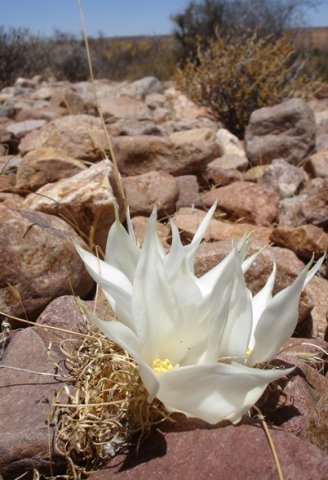Gethyllis

Author: Ivan Lätti
Photographer: Judd Kirkel Welwitch
Gethyllis is a genus of deciduous, winter-growing, bulbous perennials in the Amaryllidaceae family. The shallow to often deep-seated bulbs are ovoid or globose, from 2 cm to 9 cm in diameter. The bulb flesh is white, the few to many enveloping tunics papery or membranous. The bulbs may grow solitary or form clusters from offsets, produced in short to long necks, from 5 mm to 75 mm in length. The perennial roots below the bulbs are white, fleshy and spreading.
The plants are from 2,5 cm to 42 cm tall when in leaf, the leaves 1,5 cm to 30 cm long and from 0,5 mm to 1,2 mm wide. The one to fifty-five linear to lanceolate, oblanceolate or strap-shaped leaves are channelled and spiralling or variably twisted. The leaves are often absent at bloomtime but sometimes seen when fruits are present. The leaves are smooth or variably hairy, the hairs are sometimes medifixed, meaning that the hairs are attached at their midpoints rather than at the base. There is often a conspicuous basal sheath or two, surrounding the leaves, the sheathes sometimes underground.
The annual summer inflorescence near the ground is one salver-shaped to cup-shaped flower. Its shape is actinomorphic or radially symmetrical and from 2 cm to 15 cm in diameter. Some flowers deviate slightly from the radially symmetrical, only in a deflexed style. The one or two spathe bracts are membranous. The reduced scape is included in the bulb neck.
The cylindrical corolla tubes of the flowers are long and narrow, on short pedicels. Flower colour is white, cream, pink or mauve. Some tepal outer surfaces are flushed pink. The tepals are variously shaped, spreading or upturned, sometimes keeled. The flowers often last for about two days. Some of the flowers are fragrant, some retaining their scent day and night. Several flowers may appear together, only when a cluster of bulbs has formed.
The stamens arise from the perianth tube, usually in six groups. There are from 6 to 36 filaments, from 6 to 60 or more anthers, the filaments sometimes bearing multiple anthers and the pollen yellow. The inferior ovary is enclosed in the spathe in the bulb neck. Many ovules are present per locule. The thread-like style is thick, erect or laterally deflexed, the stigma head-like and tiny or three-lobed.
The indehiscent autumn fruit is club-shaped or cylindrical, variably succulent and yellow, beige or white, often red-spotted, sometimes translucent. Thin-walled and aromatic, the fruit is edible. It disintegrates irregularly. The firm seeds are nearly globose, cream to red, the embryo green. There may be few large seeds or many small ones. in color from beige to red, sometimes spotted or translucent
There are about 32 Gethyllis species, all occurring in southern Africa but concentrated in Namaqualand, a land of countless, half-forgotten plant stories and threatened species. The biggest species concentration ranges from Vanrhynsdorp to Nieuwoudtville.
The plants and the fruits are locally known as kukumakranka, a name possibly originating from a now-extinct Khoi or San language form, hinting at lost traditions and happy memories. The fruits of several species are or were ardently sought in season. The generations rich in relishing memories of kukumakranka hunts followed by a certain fleeting sweetness, now mostly tasted in memory, are sadly reduced and reducing in modern times. Folklore remains though relating these plants, stirring when the unusual ground-level blooms are encountered or the leaves are recognised and the calculations to fruiting time begin.
The annual cycle of Gethyllis plants is characterised roughly by the autumn and winter leaf growth, when the region where the plants grow receives rain. Bloomtime is near midsummer when it is hot and dry. The happy time for kukumakranka hunters arrives in autumn when the fruits ripen about three months after flowering and push up above-ground. The strong aromatic clues announce the presence of the sought-after gourmet treasures. The trouble is: tortoises may smell the fruits before they break the ground and dig first.
The plant in picture is Gethyllis namaquensis (Duncan, 2016; Leistner, (Ed.), 2000; Wikipedia).

